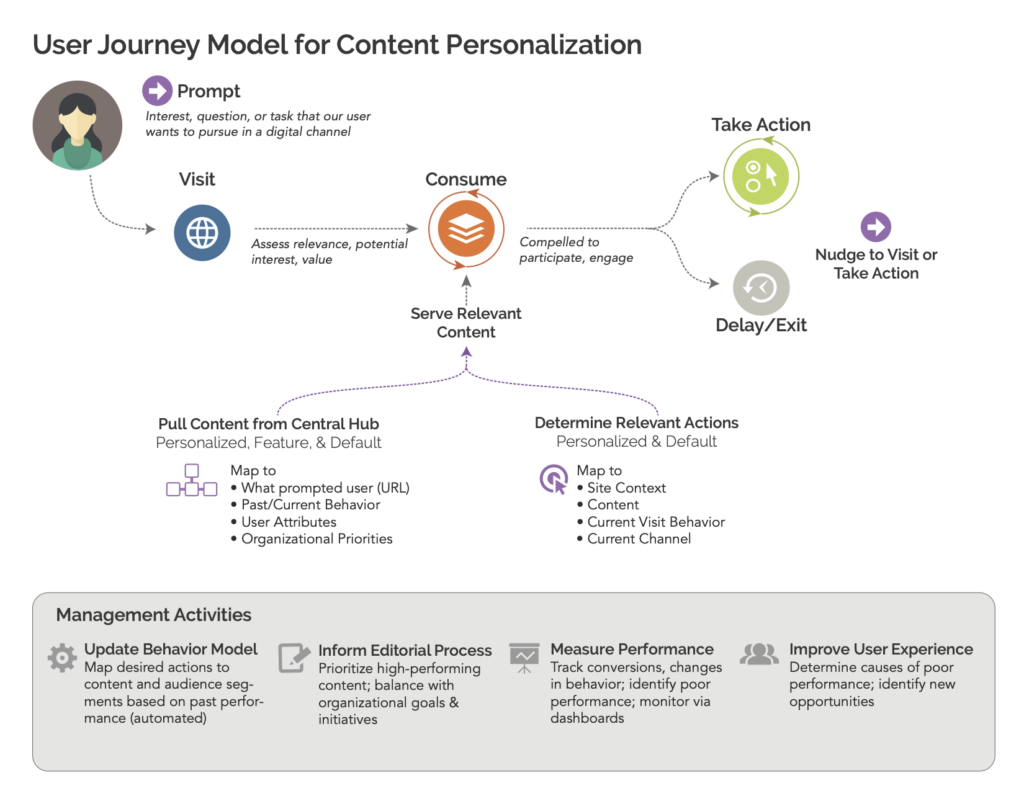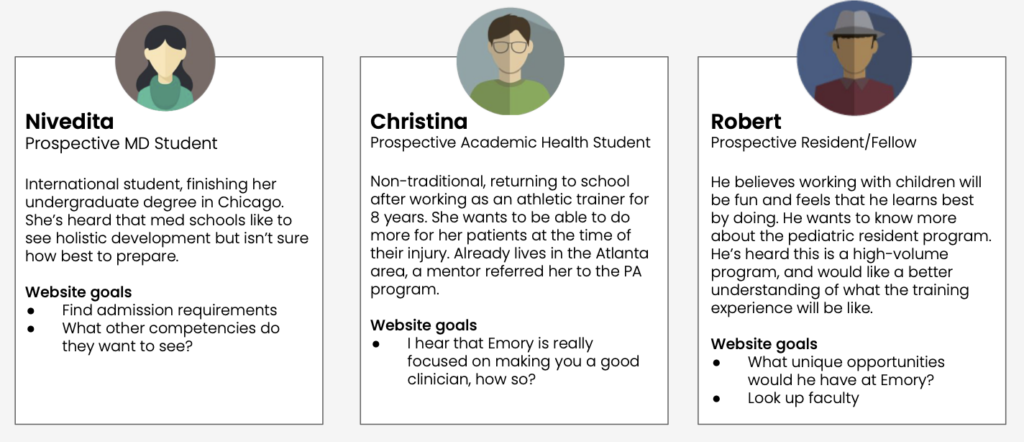This article was originally published in January 2021 on the ContentEd Conference Blog.
Does personalization make sense for higher ed sites? Is it even feasible? My goals in this article are to:
- help anyone become more familiar with the basic concepts of personalization.
- outline factors to help you decide what types of personalization might work for your organization.
- provide low-cost places to start.
Personalization isn’t just about technology
Personalization is anything you do to tailor content or communication to a particular person based on something you know about them. Many content management system (CMS) and customer relationship management (CRM) vendors tout their personalization capabilities, but technology is only part of it — you need a team ready to do ongoing content development, experiment design, testing and optimization. Personalization capabilities don’t run themselves.
Another often missed point is that any personalized experiences you create need to be tested against a control sample or a pre-personalization baseline, so you know if they’re actually improving engagement. Without that, all of your personalized experiences are just untested hypotheses. Your traffic volume will also limit how much you can personalize and how quickly, since you need enough traffic to get statistical significance for your tests.
There’s no point investing in personalization without the team to support it and a commitment to rigorous analysis. Otherwise you’re adding cost and complexity with uncertain return. That doesn’t mean you shouldn’t pursue personalization. You just need to do so in a smart way, with your eyes open.
Levels of Personalization
- Segmentation
- People are grouped into segments, and experiences are personalized for a segment, not an individual.
- You might define segments based on audience research, CRM system insights or analytics data. Some optimization platforms use artificial intelligence (AI) to identify meaningful segments among your users. Segments can overlap, so a single user might fall into more than one segment and be shown experiences accordingly.
- For example, showing all alumni under the age of 35 content about buying their first house, or showing all alumni in a particular region events for their local alumni chapter. These are segments.
- 1-1 Personalization
- Experiences are personalized based on algorithms that choose content and interactions based on things the system knows about that one person, not just the segments into which they fall.
- The simplest version of this is a mail merge — putting someone’s name into an email. A more advanced example would be showing someone news articles or student success stories based on the degree programs they have viewed on your website previously.
- 1-1 personalization beyond the simple mail merge example is generally much more costly and complex than segmentation.
What are some things you can personalize?
These are the experiences organizations commonly personalize:
- Email newsletters or campaigns
- You can segment your mailing lists based on a set of personas you define, and send different versions of the newsletter to each segment, or use a mix of standard and personalized content within the email.
- Emails or texts sent in response to various user actions or engagement levels
- These are automated emails that are sent based on some user behavior. The simplest example is a “thank you” email after making a contribution, or a confirmation email after signing up for an event. You can also set up rules with platforms like Drip (drip.com) to email someone a certain number of days after they do some behavior or action. For example, after attending an event, you might send an email 3-4 days later encouraging attendees to share their photos on your Facebook page. Any of these can be personalized further with segmentation or 1-1 personalization methods.
- Website
- You can personalize what content, calls to action or other interactions are presented to the user, based on implicit data like geographic location, referring link, or page views; explicit information the person has given you through a form; or 3rd-party data available through ad networks.
- Digital Advertising
- Gone are the days where marketers targeted users only through keywords. Now we can target by demographics, life stage events, intent to purchase, behavioral patterns, etc. As marketers start to shift away from keyword targeting (search engine marketing), audience targeting is rapidly growing. Machine learning and AI technology are providing marketers with more insights to segment their audiences. User data can be segmented not just based on target audience profiles, but on predictive algorithms that anticipate user needs and interests through the customer journey.
Personalization infrastructure
Common building blocks for personalization include:
- Content Management System
- The CMS serves a central hub for content you create, tagged with various topics and categories for easier support of segmentation. The CMS can deliver content to email, social media and other channels — not just the website.
- User Data
- The CRM stores valuable donor and constituent information, but it may not be the place where we record all digital interactions, particularly for anonymous users.
- A Data Management Platform or Customer Data Platform (CDP) stores user behavior data, preferences, cookies and insights from external sources. Can be used for real-time 1:1 engagement across channels. Google Analytics can provide a level of this, or it could be part of a personalization platform such as Evergage.
- Personalization Platform
- Selects content to present to users in various channels based on algorithms you define or through AI.
- Email Marketing Platform
- Usually has some level of segmentation and personalization capabilities built in.
- E-commerce Platform
- May have personalization capabilities such as product recommendations like “Customers who viewed this also viewed…”
- Analytics and Reporting
- Integrated with all other components for a comprehensive view of user behavior through various pathways and conversion funnels.
This diagram illustrates the components of a personalization platform and how they affect the user journey.

How much traffic do you need for personalization to work?
Your traffic volume plays a big role in which personalization methods are even feasible for you. Without enough traffic you won’t be able to evaluate the performance of personalized variations with statistical significance. AI-based personalization solutions also need enough traffic to learn and adapt. Peep Laja of ConversionXL, a global expert on conversion optimization, has these recommendations for which tools and methods are feasible at different web traffic levels:
- 1 to 5,000 visits per month
- No automated personalization is possible. In case of extreme value per conversion, focus on contacting potential customers personally.
- 5,000 – 80,000 visits per month (most higher ed websites)
- Use simple analytics-based automation (Google Analytics and Google Optimize) augmented by off-the-shelf email automation (GetResponse, MailChimp, Klaviyo etc.).
- Create a solid data collection and analysis system (usually in Google Analytics) that enables you to follow the behavior resulting from your personalization experiments.
- Set up a framework that analyzes your data monthly and generates reports for each type of experience you’re tracking.
- Create a marketing plan that leverages insights about user interests from web, social and email analytics and provides feedback to further refine your analytics.
- 80,000 – 150,000 visits per month
- The sample size is adequate to apply top-range automated personalization tools like Evergage, Intellimize, Tealium, Emarsys, etc. Prices for these tools generally start at $100K+ USD per year.
- Enables varied degrees of personalized content delivery (marketing, A/B testing, etc.) augmented by various “black box”-type machine learning algorithms
Personalization = Greater complexity
You should also ask whether you are ready for the ongoing work and complexity required for effective personalization.
Amazon and Netflix are two of the leaders we most often think of when we talk about personalization. Of course they both spend hundreds of millions of dollars a year on personalizing their experiences to increase engagement and sales, and they have the traffic to support rapid experimentation. But a recent Gartner study found that less than 10% of Tier 1 retailers believe they are highly effective at personalization. As much as one third of them have limited or no personalization going on.
While 64% of retailers have the technology to use automated personalization, study author Ismaël Sow notes that lack of technology isn’t the problem:
“As often, it’s more of a people problem than a technology problem. Having worked as a consultant at an A/B testing and personalization software company, I’ve seen many personalization efforts getting stuck in the weeds. The cause was almost always over-enthusiasm combined with total lack of process.”
Matt Gershoff, CEO of Conductrics, has this to say about the goal of personalization:
“While targeting can be incredibly valuable, many in the industry haven’t fully grasped that targeting ALWAYS leads to greater organizational complexity, and that greater complexity means greater costs.
So the question is not CAN I personalize an experience, at this point there are a thousand different tools and ways to do so. So the simple act of creating an experience is not the goal, the goal is to do so in the way that generates the greatest ROI for my organization.
The question needs to be, how do I discover the most valuable way to change the experience?”
Start small.
You don’t want to build a personalization super yacht that requires a crew of 20 only to find out you really needed a one-person racing sailboat. You need a plan that you can grow with. Consider moving into personalization in stages, starting with some basic methods you can easily support and measure.
Email is often the best place to begin. It doesn’t require a big infrastructure investment, since most email campaign platforms have the tools you need already. As you gain confidence and determine you can do more, you can go further. Marketing Sherpa has a case study describing how the charity crowdfunding website GlobalGiving.org personalized its email to achieve a 10x increase in engagement.
Persona-based content strategy, an alternative to automated personalization
If you don’t have the staff, traffic or budget to support automated personalization on your website, you can always pursue a persona-based content strategy. For most of our higher education clients, this is a much more suitable solution, and can still lead to significant increases in conversion.
To do this, create content and pathways targeting behavioral personas based on user research and analytics. The user then chooses the path that appeals to their interests, effectively personalizing their own experience simply by choosing links.

Analytics will then show how users respond to this content and where you can refine it for better engagement. If users have voluntarily registered on your website, you can incorporate these behavioral signals into your CRM and use it to better segment your email outreach.
Adopting a user-focused mindset
One of the greatest benefits of a personalization strategy is that it helps you learn about and listen to your audiences — not just one time, but all the time. It encourages experimentation and iteration. You can’t help but become a more customer-centric organization when you pursue personalization at any level.
You may never be able to pursue these more advanced personalization methods, but you can still benefit from simple email personalization and persona-based content strategy.
If you’re ready to pursue a personalization strategy for your digital communications, ConversionXL has an excellent article on the process for any personalization effort.
Do you have tips for getting started with personalization in higher education? Or case studies? Please share!

